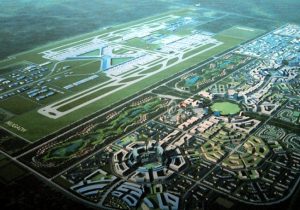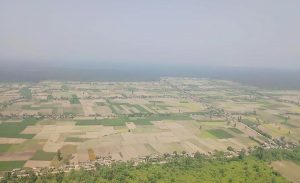
Nepal’s only international airport, Tribhuvan International Airport, was already tainted with the crash of Thai Airways International Flight 311 and Pakistan International Airlines Flight 268 in 1992. Following those incidents, in 2015, Turkish Airlines Flight 726 skidded off the runway during a poor-visibility approach to Kathmandu. As a result, the airport was shut down for four days. Then more than ever, the necessity of another international airport became more evident since then.
For the past few years, the government has been constructing international airports in Pokhara and Bhairahawa whereas another major project has been proposed. The proposal for the Nijgadh International Airport, however, has come under a controversy owing to environmental costs. Currently, the project has been stalled due to different reasons, but apparently, the government wants to proceed with its construction as soon as possible.
But, what is the debate all about?
Do we need a fourth international airport?
Undoubtedly, the Tribhuvan International Airport (TIA) is highly congested and saturated. The air traffic growth in Nepal is 9.2%, which exceeds the 7% growth in the Asia-Pacific region. According to the Civil Aviation Authority of Nepal (CAAN), the number of passengers using the TIA increased twofold between 2009 and 2018. The airport has a capacity of about nine million people per year. The number of passengers using an international airport in Nepal is expected to exceed 15 million by 2030. Accounting for this growth rate, a few years from now, TIA (~5 million), Gautam Buddha International Airport (GBIA) (~1 million) and Pokhara Regional International Airport (PRIA) (~1.5 million) combined cannot handle the then created air traffic. Due to high air-traffic congestion, aircraft at the TIA are frequently put on hold, increasing their carbon emission. A plane from Thai Airlines burns 6.5 tonnes of fuel per hour which equals to the emission of ~20 tons of carbon dioxide. Furthermore, an instrument landing system (ILS) cannot be installed in the TIA due to the bowl-shaped topography which compromises the safety of the passengers and aircraft.
Due to various constraints, none of these airports among the TIA, the GBIA, and the PRIA, can qualify as a full-fledged international airport. To welcome the new large aircraft (NLA) category 4F aircraft such as Boeing 747 300 series, Airbus a380, Nepal needs an airport that complies with all the international standards.
Why Nijgadh ?
The selection of the site is justified from various aspects. To begin with, it is ~62 km south of Kathmandu; an international airport must be within a one-hour driving distance from a major city. Only 100 nautical miles are required for descent from 29,000 ft (cruising altitude) to this location while being inside Nepal’s airspace.
The runway is proposed parallel to the India border; 15 km away from Churia Range, 27 km from the southern border, and 45 km from the western border. Thus, there will not be any problems with airspace during holding at this place.
It is situated between two rivers ~10 km apart on plain land decreasing the cost of cut and/or fill during construction. The cost of transportation of construction materials from Birgunj is minimal. It is also located near major cities such as Biratnagar and Chitwan. There are three air-entry points from India, from Janakpur, Biratnagar, and Bhairawa, which are all viable from Nijgadh.
None of the alternative airports/sites are deemed worthy at this level. The selection of the site for an airport of this scale is not a child’s play. Various factors such as location, the topography of the area, and its surroundings, wind direction, and climactic conditions should be taken into consideration. A short distance from Kathmandu is also crucial. Both the PRIA, having a smaller area and topographical difficulties, and the GBIA, being at a distance from Kathmandu, cannot serve as an alternative. The TIA expansion is impossible due to topographical limitations and haphazard urbanisation. The area of Nijgadh is the best possible site for the construction of an airline hub of this scale; this is backed up by the many feasibility study reports.
The development of a full-fledged airport would help promote Nepal as not only a tourist destination but also a transit hub in South Asia. It would also foster economic development and boost Nepal’s connectivity with the rest of the world. It will enable direct long-haul connectivity to countries in North America, Europe, and Australia. Along with the airport, the construction of an airport city in the area would pave the way towards Nepal’s development. A portion of the generated revenue can be utilised on tree plantation.
Why protests then?
Despite its necessity, this project is a nightmare for the surrounding environment. The forest area of 7,002.79 ha with 2.45 million standing trees will be cleared instantly; this is just the tip of the iceberg. It will irreparably affect the environment. This forest area can transpire up to 81.96 tons of water a year into the atmosphere. Losing these many trees would also mean a loss of ~0.28 million tons of oxygen in the atmosphere annually. Cutting these many trees could lead to ~650 million kg of rainwater not being absorbed by the forest anymore, which leads to possible soil erosion and flooding.
An environmental impact assessment report describes the project area as one of the richest forest biodiversity areas in Terai. The forest is home to around 500 species of birds, 33 species of mammals, 23 endangered floras, and 22 endangered wildlife species. Due to this, the site is also prone to bird hazards in the operational phase. Say the trees would be replanted through afforestation programmes, but what about the biodiversity of the region and the natural habitat of birds, animals, and insects?
Along with the biological environment, the physical environment is also susceptible to the same scale of deterioration. With the construction and operation of the airport comes the pollution of air, noise, water, and land. Constructional impacts include changes in land use and in the drainage network, possible flooding and soil erosion, and operation of the work camps and of quarry sites. Operational impacts include changes in surface hydrology and groundwater hydrology, soil erosion, and changes in the microclimate, which ultimately leads to climate change. The proposed site also has a higher water table that increases the chances of arsenic contamination at the downstream over time as the air traffic increases. Similarly, the people living in Tangiya, Matiyani, and Kathghat settlements in the project area will be displaced, leading to the displacement of 7,487 people living in 1,492 households. There will be devastating effects on the income sources of these people who rely on irrigation, animal husbandry, and fishery.
Environmentalists also have doubts about the government’s plan of action. The feasibility reports and the detailed project report (DPR) have not been made transparent by the government, which raises even more questions. The reports on why Nijgadh is specifically chosen instead of alternative sites have still not been made public. They fear that Nepal cannot handle the environmental and economic costs of Nijgadh International Airport and the airport city and Kathmandu-Nijgadh Fast Track.
It is true that there is only a fine line between development and destruction. Thus, the government must decide whether the juice is worth the squeeze. Before the clearing of the forest, the government must make sure it can make the project worth it. Also, the government must ensure the transparency of the documents regarding the project. The government must further study the practicability of a 1:25 tree plantation solution. One can only hope that Nijgadh International Airport does not become the government’s white elephant.
Mahat is an engineering student and an international affairs enthusiast.






















